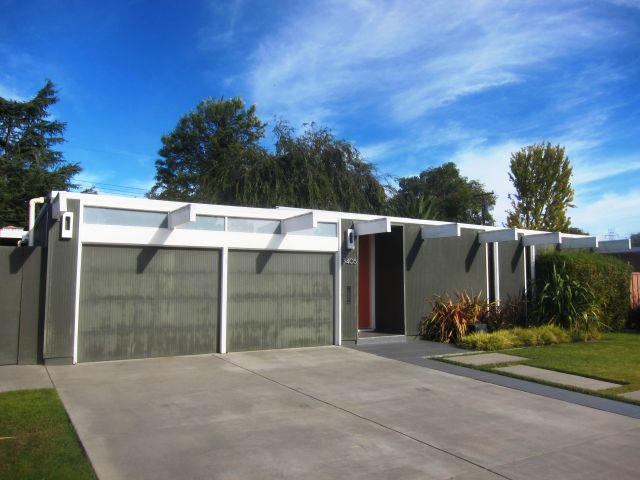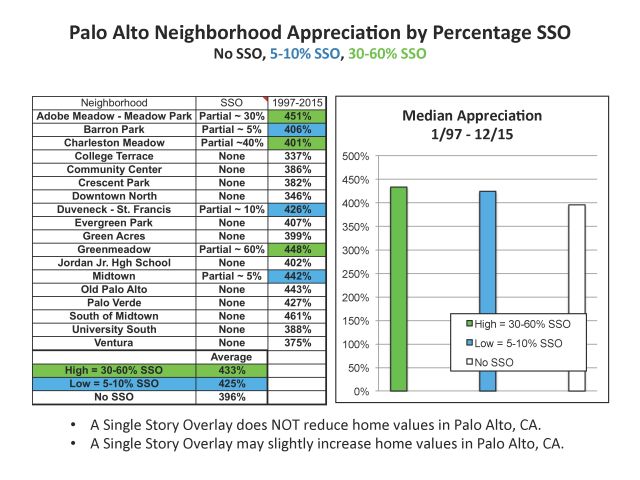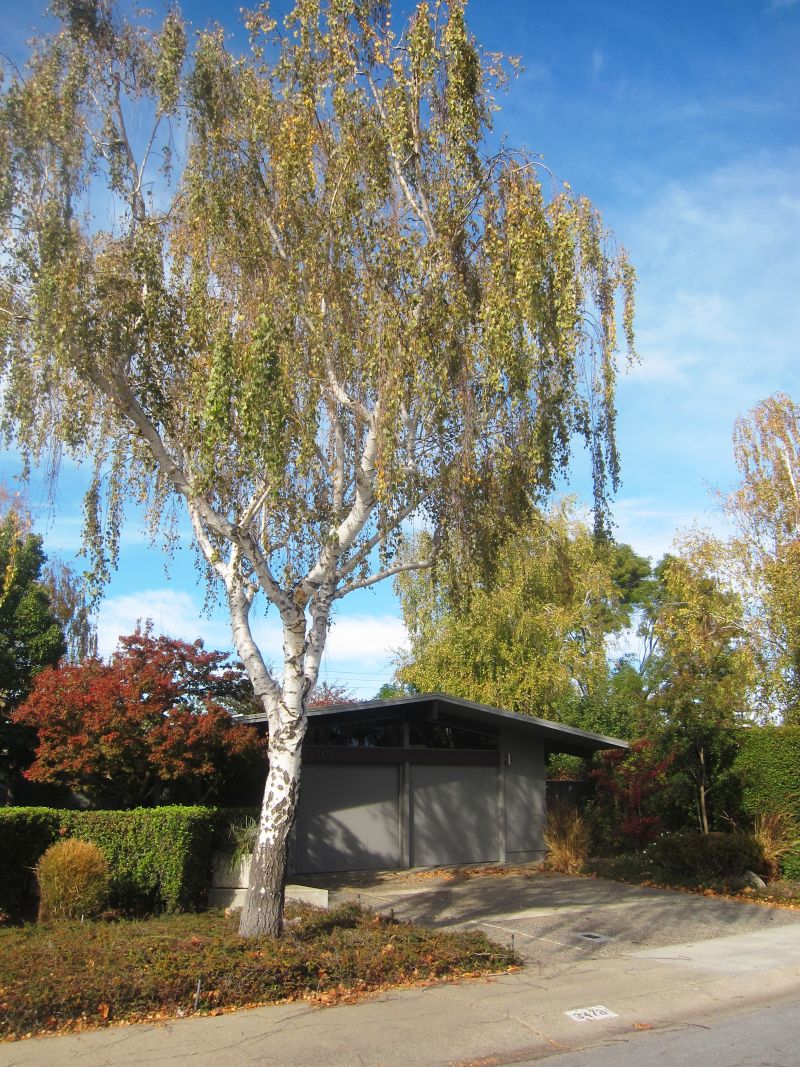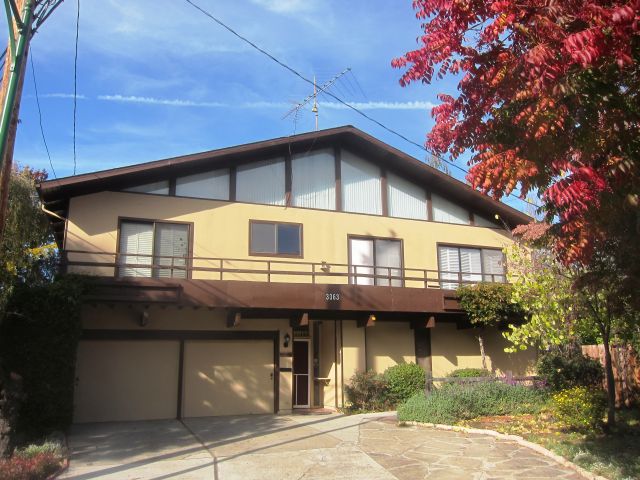
Bringing Data to Bear Helps with Teardown Fight
 |
|
|
It’s an argument you may have heard many times, may even have argued it yourself: "Yes, banning second-story additions and two-story replacement homes in our modern neighborhood may preserve its look and our quality of life. But it will drive down home values."
Not so says Eichler owner David Hanzel, who has data he says proves it.
Using data available to anyone with access to the real estate website Zillow, Hanzel charted how home prices appreciated in 18 different Palo Alto neighborhoods, those that have single-story overlays and those that don’t.
No, the data do not cover only Eichler neighborhoods, but rather, Eichler neighborhoods grouped with nearby non-Eichler neighborhoods. But Hanzel did take into account what percentage of the homes in each neighborhood were covered by single-story overlay zones, which ban second-story additions.
The data run from 1997 to 2015. Hanzel, who lives with his family in the Palo Alto Eichler neighborhood of Royal Manor, packaged the results in a short document, ‘How do SSOs Affect Property Values,’ and made it publicly available. His goal is to help fight the wave of teardowns that has been threatening Eichlers in Palo Alto and nearby cities.
 |
|
|
What the data show, he says, is, “In general, Palo Alto neighborhoods appreciated similarly” over those years. “There is no evidence for 20 years that having a single-story overlay compromises the value of homes at all,” he says.
A chart in his document shows, for example, that homes in the Adobe Meadow-Meadow Park area, where overlay zones cover 30 percent of the homes, appreciated by 451 percent – the highest appreciation in any neighborhood.
In the neighborhood of Greenmeadow, where 60 percent of homes are covered by such zones, the increase was 448 percent. (Note: all homes in the Eichler subdivision of Greenmeadow, a subset of the Zillow Greenmeadow district, are protected by overlay zoning.)
The lowest rate of appreciation was in a neighborhood with no overlay zone, College Terrace, clocking in at a 337 percent increase.
Hanzel, who grew up in an Eichler in Terra Linda in Marin and has lived in his Palo Alto Eichler for 20-plus years, says it took him only a few hours to compile this data and make it presentable.
“This is what I do for a living. I do a lot of data analysis,” he says. Hanzel, a biologist by training, is a consultant in the field of biotechnology.
 |
|
|
Hanzel is a strong proponent of single-story overlay zones to save Eichler neighborhoods. He is part of the group that has been working for more than a year in Royal Manor to obtain such zoning. He notes that he is not one of the leaders of that group.
“I’m very careful not to conclude that [a single-story overlay] will increase home values,” he says. “All I can say is there is zero evidence that it decreases them."
And Hanzel is not the only person in town who understands data. He and other single-story overlay proponents have used his data. They have pulled it out at city meetings when the City Council approved the last overlay zone it granted, for Greer Park North.
And the Royal Manor proponents have used the data when canvassing neighbors for needed support. It worked, Hanzel says. “People said, ‘David, I’m really worried about my home values.’ I said, ‘Well, it looks like no problem.’”
Their response? “ ‘All right. Fine. Done. I’ll sign.’ A lot of people [in Royal Manor] are engineers. They’re rightfully concerned about the value of their homes. But they will accept data,” he says.
 |
|
|
But, no, the historic data hasn’t convinced everyone. “People have their preconceived notions,” Hanzel notes.
There is also the argument that things have changed since the 1997-2015 era. Home prices are soaring so quickly now, and the demand for raw land in Palo Alto is so great, that perhaps appreciation in home values will be lowered in neighborhoods with two-story bans in ensuing years?
“That’s a hypothesis,” Hanzel says, “but there is no data behind it. I’m a data guy and there is really good data available to the public on home values in the past 20 years.”
Palo Alto’s Planning and Transportation Commission recommended approval of Royal Manor’s overlay in early February, sending it on to the council. The 200-home community would be the largest to win such zoning since the movement took off here in town last year.
The first was Los Arboles, followed by Greer Park North. Greer Park North won City Council approval in December.
Although there have been no teardowns in Royal Manor, folks watched as a home was torn down nearby, across from the Eichler Swim and Tennis Club, to be replaced by a two-story home. A similar episode also played out, with an Eichler on Richardson Court.
 |
|
|
A number of residents of Royal Manor have opposed the overlay plan, in part because they are afraid of the impact on their property values.
Hanzel agrees there was more opposition to the zoning change than in some other neighborhoods, “but that’s because we’re a much bigger neighborhood, more than 200 homes.”
The planning commission, in giving general support to the overlay zone, suggested that Stockton Place and Loma Verde Avenue be excluded, because some residents there opposed the change.
The City Council is expected to take up the matter in mid-April.
“We’ve spent hundreds and hundreds of hours on this,” Hanzel says, meaning the eight or so Royal Manor residents who have been leading the charge. He says neighbors from Royal Manor, Greer Park North, and Los Arboles have worked together, sharing ideas and providing encouragement. “We know people in those neighborhoods. We’re trying to support each other.”
Hanzel suggests that sort of cooperation could extend beyond Palo Alto. “If somebody wants to do it for their Eichler neighborhood, I could help them do it,” he says. “I’d like to see it done in Marin.”
The author of this blog will be pleased to help anyone seeking David Hanzel's help in this matter to contact him.
- ‹ previous
- 78 of 677
- next ›



